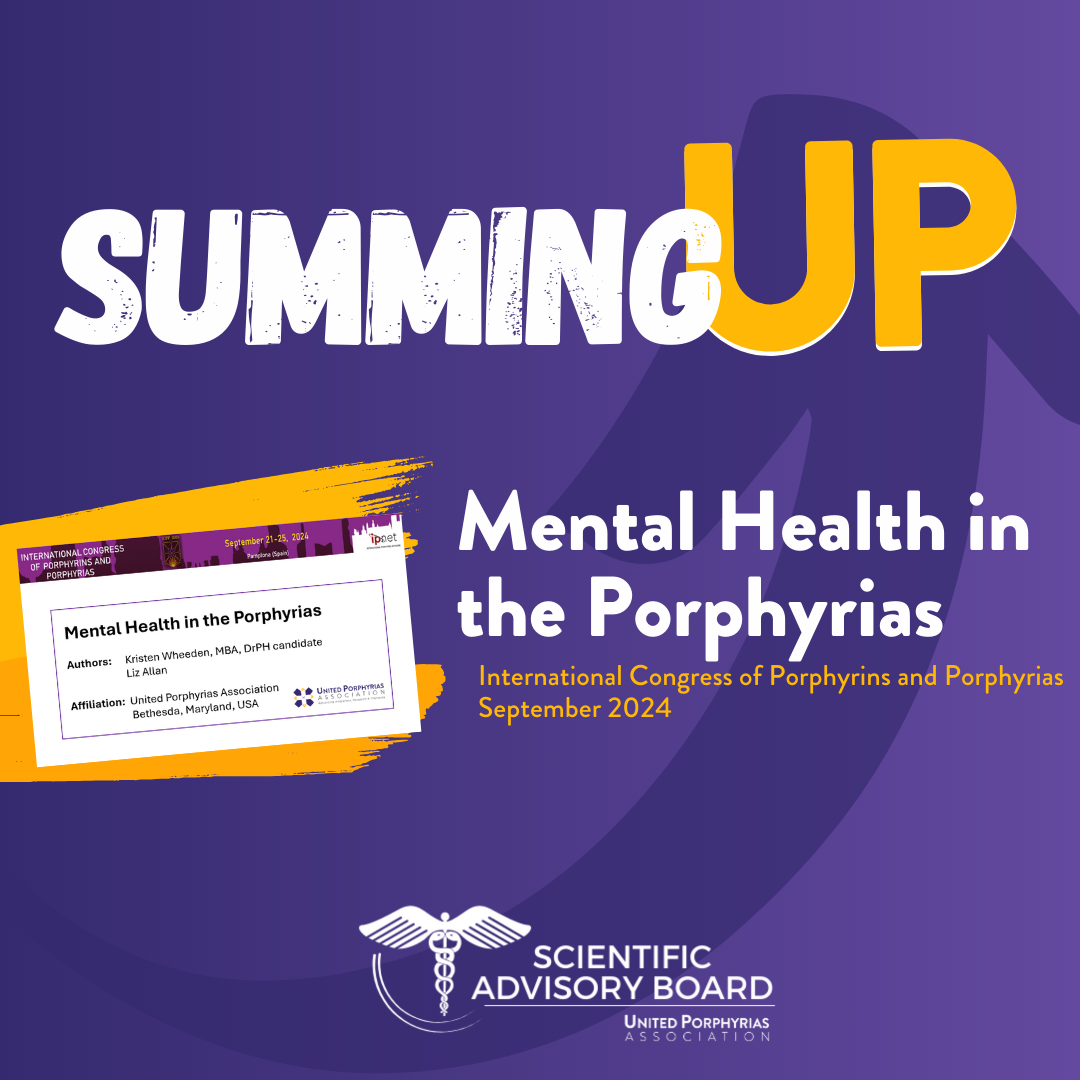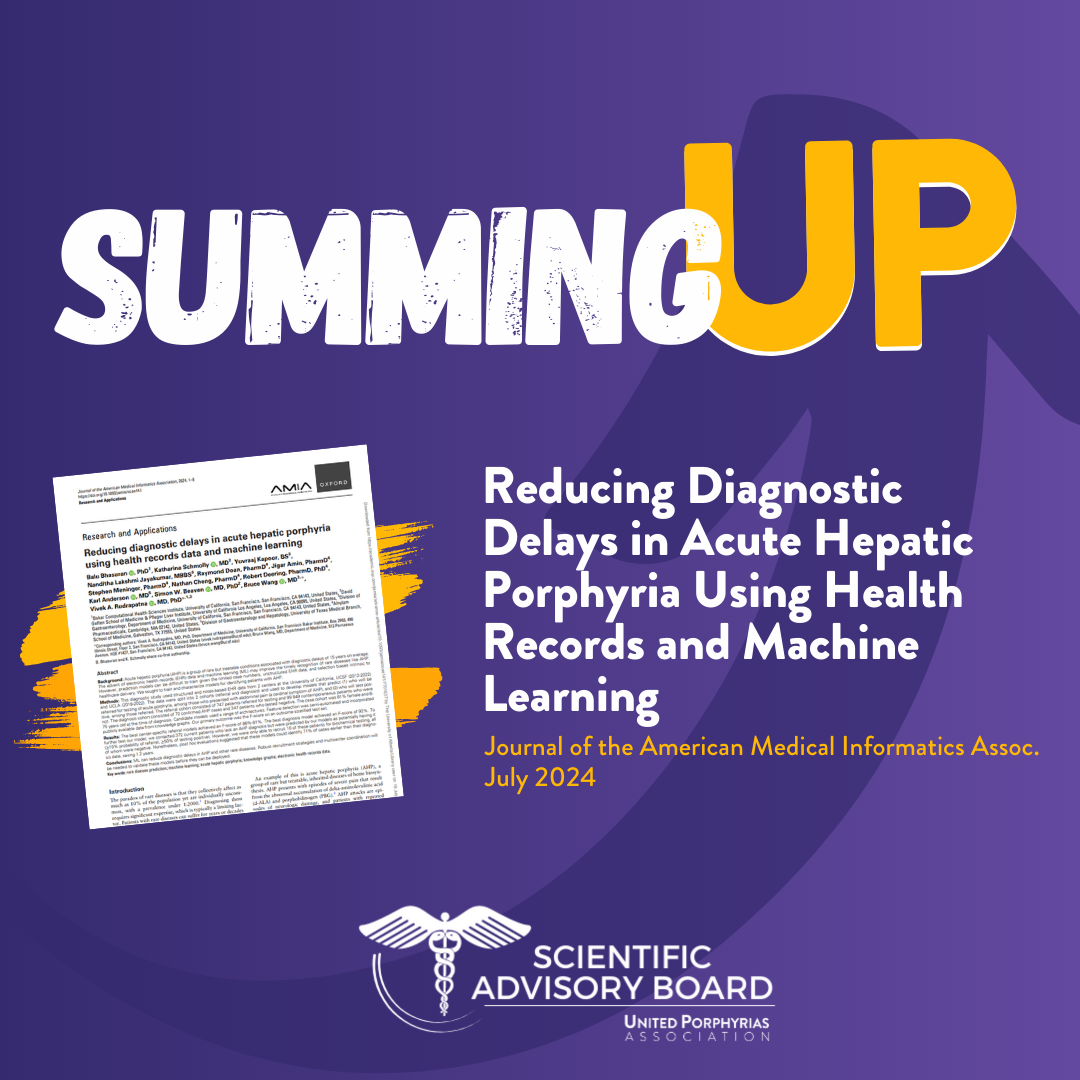Pain in Acute Hepatic Porphyrias
Summing UP features the latest porphyria research in easy-to-understand summaries that have been reviewed and approved by the UPA's Scientific Advisory Board of porphyria experts.
Pain in acute hepatic porphyrias: Updates on pathophysiology and management
Published in Frontiers in Neurology, November 2022
Original article: https://www.ncbi.nlm.nih.gov/pmc/articles/PMC9719963/
Pain- both acute and chronic- is a prominent part of acute hepatic porphyrias (AIP, VP, HCP, ADP). This article was originally published in November 2022 and provides an overview of the different types of pain and how they may be treated.
What causes pain in acute hepatic porphyrias?
It is believed that the build up a molecule called ALA is responsible for acute hepatic porphyria symptoms. ALA may interfere with your nerves from properly receiving and sending messages, or it may impair or damage parts of your nerves. The ends of your nerves in your gastrointestinal tract are less shielded than other nerves in your body, which may be why abdominal pain is so common. Nerve roots (the start of the nerve near the spinal cord) are also less shielded and appear to also be more sensitive to ALA. This may be the reason why pain and numbness seems to start in the lower back and move to the limbs.
The reasons for chronic pain are still not well understood, it could be that ALA levels still remain high in the body and interfere with sending messages, that the nerves are damaged and more active/sensitive during recovery from an attack, or that after a while of being in pain the brain and spinal cord started to secrete certain molecules that keep the nerves irritated all the time.
Pain during acute attacks
Severe abdominal pain is reported in most patients. It generally lasts several hours to days and is often accompanied by nausea and vomiting. The pain can be colicky (varies in intensity) or gnawing/aching and may be more intense in a specific area or generalized over the whole abdomen. Test results often do not detect anything abnormal.
Patients may also experience lower back or limb (arm or leg) pain. The pain may be severe and achy in the muscles and/or feel closer to the skin and burning. This pain may also be accompanied by numbness, weakness, increased sensitivity to stimuli, or sensations like pins and needles, or burning.
Headaches are less common during attacks but can be severe. They are associated with high blood pressure and may also be associated with swelling of the brain (brain edema).
Pain between attacks
Most patients do not experience porphyria pain outside of attacks, however for some the pain can be chronic.
Patients with recurrent attacks are more likely to experience chronic pain. This can have a significant impact on daily life. The most common chronic pain types are: abdominal pain, headache, back pain, limb pain, and deep, aching pain. Tingling and burning, and numbness are common, and the pain may not be very responsive to medication.
In addition to chronic pain, recovery from an acute porphyria attack can be a long process (up to two years) during that time pain from attack damage may continue.
Managing pain during acute attacks
Treatment with heme in the first days of the attack limits the progression of the attack in terms of pain and neuropathy (nerve damage), and recurring attacks can be treated with recurring heme infusions or givorsiran injections. Additionally during attacks, pain should be treated immediately with opioids, benzodiazepines can be used for pain and anxiety, respectively. Medications like pregabalin and gabapentin should be used when neuropathy (nerve damage causing numbness or tingling) is present.
Rehabilitation, including stretching, sensory reintegration and psychotherapy should be included as part of rehabilitation after an attack and can help reduce chronic pain. Opiates should be replaced with less addictive pain relief as early as possible and are not recommended for long-term use after discharge.
Managing pain between attacks
The first line of treatment for chronic pain are types of antidepressants (serotonin-noradrenaline reuptake inhibitors and tricyclic agents). Some anti-seizure medications (pregabalin or gabapentin) are also recommended, however there is a potential risk of abuse, and complications if combined with opioids.
For severe pain, a short-term opioid regimen or heme on-demand infusions may help.
Medications like NSAIDs (ex. aspirin, ibuprofen, naproxen) and acetaminophen can help with mild muscular pain but are not helpful if the pain is related to nerve damage.
Preventing recurring attacks helps reduce pain. Healthy lifestyle modifications including adequate nutrition, cessation of drinking and smoking, and stress coping strategies should be adopted Givosiran injections or prophylactic hemin infusions may reduce attacks.
Note: not all medications are safe for porphyria, and the article contains this table with the safety profile of common pain and nerve-related medications.
Conclusion
The pain associated with acute hepatic porphyrias has a profound impact on patients. AHP pain is primarily neuropathic, which means it is caused by damage to the nervous system, likely by a molecule called ALA. Treatment of AHP pain depends on whether it is an acute attack or chronic pain.
CONTENT REVIEWED BY UNITED PORPHYRIAS ASSOCIATION SCIENTIFIC ADVISORY BOARD






